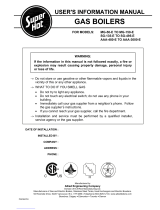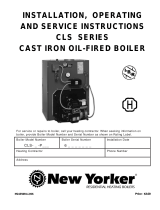GALAXY STEAM BOILER 14
C. Open the SKIMMER drain valve with caution. DO NOT open the
boiler drain valve. Fill the boiler slowly until water begins to seep
into the bucket from the skimmer drain blow-off connection. Fire the
boiler. Allow water to heat up while water seeps into the bucket.
Maintain that water level necessary just to be able to continue skim-
ming. Continue until water is clean and no oil can be seen floating in
the bucket. Empty bucket frequently in order to see if the water is
clean.
D.Repeat this process until all film is skimmed off, lower the water
level to 25-1/2" from the bottom of the boiler (see Figure B).
When all surging has stopped, turn off the boiler, remove skim-
mer valve and plug the tee. Check the pop safety valve for
proper operation.
E.The entire process may have to be repeated over a period of a
few days on extremely fouled systems.
3. CLEANING PIPING SYSTEM
A.To clean piping system, open all valves at the heating elements,
after getting up a good head of steam, shut the boiler down and
allow the condensate to return to the boiler. The condensate will
carry the oil film with it. Again blow-off the boiler. On extremely
fouled systems, it may require several visits over a period of a
few days to clean the system.
B.When steam only (no water) is released through the hand
valve, the boiler will not surge or flood.
CARE AND MAINTENANCE
WARNING: THE FLOW OF COMBUSTION AND VENTILATING AIR
TO THE BOILER SHOULD NOT BE OBSTRUCTED.
This section must be brought to the attention of the owner by the
installer so that the owner can make the necessary arrangements
with a qualified service agency for the periodic care and mainte-
nance of this boiler. The installer must inform the owner that the gas
supplier can recommend a number of qualified service agencies.
The installer must also inform the owner that the lack of proper care
and maintenance of this boiler and any fuel burning equipment may
result in a hazardous condition.
1.
GENERAL MAINTENANCE (Refer also to User's Information Manual)
These operations are recommended to be performed at regular intervals:
A. BOILER HEATING SURFACES: clean off all coatings found.
B.
BOILER CONTROLS: check contacts, settings, correct functioning.
C.PIPING: check piping and accessories for leaks.
D. CHIMNEY and BREECHING: check for obstructions and leaks.
E. BOILER ROOM AIR SUPPLY: check air vents for continued POSI-
TIVE supply of air as required. Air needs are greatest in cold
weather. Air vents must be open and free of obstruction.
2. WATER LEVEL CHECK DURING HEATING SEASON:
A.Check water level regularly and add water slowly to system
when needed. If much water is added, venting may be nec-
essary.
B.Regular loss of water from water boiler system may indicate
either a system leak, or a faulty air-control system, or a
faulty automatic fill valve.
3.. ANNUAL INSPECTION AND CLEANING:
A.It is important that this boiler be inspected by a competent servi-
ceperson to help insure safe and reliable operation.
B.Check for gas leaks from valve and gas piping to burners and
pilot. If leaks are found, repair or replace as required.
C.This inspection should include:
1. Controls check. See SAFETY CHECK, IV. on page 16.
2. Recheck of input gas rate to burners. See "Initial Start"
paragraph in "Operating Instructions" section.
3.
Re-adjusting for best flame characteristics of main flame and pilot(s).
See "Initial Start" paragraph in "Operating Instructions"
section and see "Burner Adjustment" section.
4. Burner and boiler flue passage cleanliness: BURNER
AND FLUE CLEANING (see sketch). It is suggested that
paper be placed on burners to collect any foreign material
in cleaning flues.
5. Remove draft hood, jacket top and flue cover.
6. Use wire brush to clean flueways.
7. Replace flue cover and re-seal with furnace cement.
Replace jacket top and draft hood and reconnect to smoke
pipe, using screws. Remove and dispose of paper and
accumulated material.
8. If burner surfaces are not clean, or if uneven flame indi-
cates plugged burner ports, remove and clean burners.
NOTE—TO REMOVE BURNERS:
a. Disconnect pilot at pilot mount, or disconnect pilot gas line at
gas valve, before removing burners next to pilot.
b. Lift rear of burner and remove burner from orifice.
c. Clean and replace burners* and pilot. Adjust burners as
described on page 11.
* To clean burners run a clean flue brush up the tube until
all foreign matter is removed.
4. SAFETY CHECK FOR CONTROL SYSTEM
A.Gas valve safety shutdown test:
1. For boilers equipped with Honeywell S8600F or M or
S8670E intermittent pilot system, with main burners firing,
disconnect the ignition cable from the S8600F or M or
S8670E IGNITOR BOX. The gas valve should shut off the
main burners.
If the gas valve fails to shut down main burners when the
test in 1 or 2 is performed, replace the gas valve.
B.Check for gas leaks from valve and gas piping to burners
and pilot. If leaks are found, repair or replace as required.
5. Water Treatment:
A good water treatment program will not only extend the useful life
of this boiler but it will also save much of the time and expense of
repairs made necessary by preventable occurrences.
A reputable water treatment company should be consulted to eval-
uate and determine the best overall treatment program for your
boiler equipment.
6. KEEP THE BOILER AREA CLEAR AND FREE FROM COM
BUSTIBLE MATERIALS, GASOLINE, AND OTHER
FLAMMABLE VAPORS AND LIQUIDS.
WARNING:
The ceramic combustion chamber in the burner box contains crys-
talline silica. Wear proper dust mask and gloves when servicing
combustion chamber or burners. Crystalline Silica has been identi-
fied as a carcinogenic or possibly carcinogenic to humans.
Boiler Cleaning





















